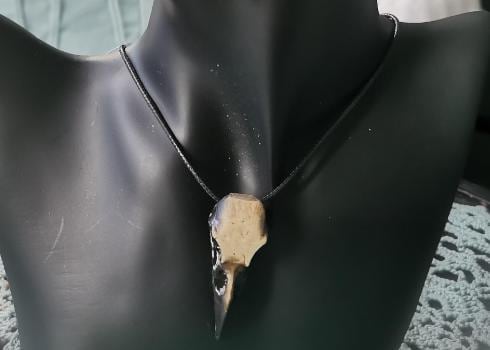First, let’s get to know the creatures behind the skulls. Ravens and crows both belong to the corvid family, known for their intelligence, problem-solving skills, and complex social behaviors. Though often confused, ravens are generally larger, with deeper voices and wedge-shaped tails, while crows are smaller and tend to be more adaptable to human environments. Both have been symbols in mythology, folklore, and spirituality for ages. But why the skulls? In spiritual practices, the skull often represents more than death—it stands for change, the cycle of life, and deeper knowledge. When connected specifically to ravens or crows, the symbolism becomes even more powerful.
In most spiritual traditions, the skull—especially that of a raven or crow—is a direct reminder of mortality. These birds are often seen near graveyards or places of decay, scavenging or perching like sentinels. This association with death isn’t necessarily negative. In fact, many spiritual belief systems view death not as an end, but as a transformation—a shift from one state to another. In Norse mythology, Odin, the god of wisdom, war, and death, had two ravens, Huginn (thought) and Muninn (memory), who flew across the world gathering information. These birds were seen as extensions of Odin’s mind, suggesting that death and knowledge are linked. The raven skull, then, becomes a symbol of insight that comes only after deep transformation or loss. In modern spiritual practices, people may keep a raven or crow skull on their altar to represent letting go of old beliefs, habits, or identities—like a shedding of skin. The skull becomes a physical reminder of spiritual evolution and rebirth.
Crows and ravens are often considered messengers. Their dark color, eerie intelligence, and presence during quiet, contemplative moments give them an aura of otherworldliness. In many Native American traditions, the crow is seen as a trickster and messenger between the material and spirit worlds. The skull of such a bird, then, is like a key—a sacred object believed to help the living communicate with spirits or access hidden truths. Shamans and spiritual seekers may use crow or raven skulls in rituals to call upon guidance from ancestors or the unseen world. Some even meditate with these skulls nearby, seeking clarity or answers. The idea is that these birds—so often present at the crossroads of life and death—are in a unique position to guide us through spiritual questions and personal crises.
Despite their eerie reputation, crows and ravens are also associated with protection. These birds are incredibly loyal and protective of their groups. Spiritually, their skulls are thought to ward off negative energy or psychic attacks. Some practitioners wear jewelry shaped like crow or raven skulls, not for fashion alone, but as amulets of protection and wisdom. There is also a long-standing belief that crows and ravens possess “forbidden” or hidden knowledge. In Celtic mythology, the goddess Morrigan is often associated with the raven. She is a deity of war and fate, but also prophecy and transformation. Her connection to ravens makes the skull of one a powerful symbol of deep, intuitive understanding—especially the kind that arises in dark or challenging times. When someone keeps a raven or crow skull in a spiritual context, it may represent a desire to connect with ancient knowledge, to understand the darker aspects of life, or to find strength during chaos.
In psychological and spiritual circles, “shadow work” refers to the process of confronting and integrating the hidden or denied parts of ourselves. The crow or raven skull is a fitting symbol for this kind of journey. These birds, which thrive in death and decay, remind us that there is value in what we might otherwise try to avoid—like grief, fear, or the unknown. In rituals or personal reflection, the skull becomes a kind of mirror. It asks the seeker: What must be faced? What truth is being ignored? What part of yourself have you buried? By invoking the energy of the raven or crow, spiritual practitioners aim to face their inner darkness not with fear, but with courage and curiosity.
Beyond traditional spirituality, raven and crow skulls have also found their place in modern art and symbolism. You’ll often see them in tattoos, jewelry, and even home décor—not just because they look cool, but because they carry deep, personal meanings. For some, a crow skull tattoo might represent surviving a difficult time. For others, a raven skull pendant may be a reminder of a loved one who has passed, or a connection to the mysteries of the universe. The meanings are as varied as the people who hold them. What makes these symbols powerful is not just their historical or cultural roots, but the personal stories we tie to them. A skull may once have been feared, but through spirituality, it becomes a symbol of strength, wisdom, and hope.
The skulls of ravens and crows are more than curiosities or gothic ornaments. In spiritual traditions around the world, they represent deep truths: the cycle of life and death, the power of transformation, the call to explore the unknown, and the wisdom found in darkness. Whether placed on an altar, worn as jewelry, or simply reflected upon in moments of quiet, they remind us of the beauty in endings, the potential in beginnings, and the sacred space in between. So the next time you see a raven or a crow, or come across an image of their skull, take a moment to reflect.


